The most famous carriage in the Dutch royal stables is without doubt the Golden Coach. The Berline was designed and built 1897-1898 by the carriage manufacturer of the brothers Spyker. It was made of teak wood, covered in gold leaf, in Dutch Renaissance style. The coach is decorated with paintings by Nicolaas van der Waay. More than 1,200 people were involved in building the coach.
The coach was a present from the people of the city of Amsterdam to Queen Wilhelmina. The idea came from the board of the “Oranjevriendenkring” (Friends of Orange) of the Willemstraat in Amsterdam. At the time Spyker had just created a gala coach for a Prince from the Dutch Indies, and one of the members of the board had seen it. Something like that should become their present for Wilhelmina. All other “Oranjevriendenkring” in Amsterdam were enthusiastic. The “Vereeniging van het Amsterdamsche Volk tot het Aanbieden van een Huldeblijk aan H.M. Koningin Wilhelmina” was created to collect the money.
Originally the coach was meant as a present for Wilhelmina on the occasion of her inauguration as Queen of the Netherlands on 6 September 1898. Wilhelmina had however requested not to give her any presents for the occasion. Many letters were sent to The Hague, several times the board visited. At court they loved the plan, and finally Wilhelmina agreed to receive the present on a date she would choose. The board and Spyker wanted the coach to be created by Dutch industry, art and workers. And Dutch products were used as much as possible. Several companies were hired to create precious and artistic work for the coach.
The sculptures
On top fo the coach is a sculpture, created by Crevels and Van den Bossche, showing four females depicting trade, work, shipping and agriculture. They are holding the Crown of Orange on a pillow with the royal crown, scepter and the sword. On the four corners of the top of the carriage one can see two children’s figures wrapping the royal coats of arms with laurels. The cornice is also decorated with the coat of arms of the (then) eleven provinces of the Netherlands and the city of Amsterdam. Cerubs weave wreaths around the royal initials above the doors.
The four corners of the cornice are supported by four atlant, carrying lanterns that can also be used for electrical lighting. Under the windows of the carriage one can recognise more symbols for religion, army, law, art, science and labour. Furthermore the carriage is decorated by horns of abundance, and jesters holding handles made of ivory from Sumatra, lilies and roses, as a symbol of fidelity. In their hands is a cartouche with the year 1898. Two roaring lions close the back of the carriage with a chain.
Both sides of the state box include the national coat of arms, and who looks closely also discovers swimming birds. The four wheel covers are the suns depicting the “mildly shining kingship”. The rims are decorated with signs from the zodiac. The hinges and door locks are decorated with dogs and owls, symbolizing loyalty and vigilance. On the steps of the coach one finds water lillies.
The painted panels
The Dutch decorative artist Nicolaas van der Waay was asked to paint the allegorical illustrations on the coach. At the time he was a professor of the State Academy of Visual Arts. The four panels depict the past and the present, the future of the Netherlands. The main figure is the Dutch maiden.
The painting at the back of the coach shows Clio, the muse of historiography, who represents the tribute of the people at the inauguration of Queen Wilhelmina, immortalized in the book of time held by Chronos. The god of trade, Mercury, holds the arms of Amsterdam. A dog, symbolizing faithfulness, holds the coat of arms of the Kingdom of the Netherlands. In the background one can recognise Amsterdam with the Royal Palace and the Neew Church.
The right panel shows the present and the Homage to the Netherlands. A naked boy depicts the young Dutch people. The main figure is Netherlands-Orange surrounded by allegorical personifications of peace, education, faith, agriculture, livestock, trade, industry, music, poetry, science, law and the army.
The front panel symbolizes the ideal future with improved social facilities. Lady Justice represents the law and protects people in need. Also present are education and health.
It is the left panel that is most controversial nowadays: Homage of the Colonies. At the time the East and West Indies were Dutch. The Dutch maiden is holding the skin of a carcass as a sign of great worship. She is surrounded by a view on the East Indies and an Indian Prince, dignitaries and residents, four people bringing civilization and development to the colonies and products fro the West Indies. In recent years there was a discussion as the panel shows half-naked slaves submitted to the royal family according to some, alhtough historians say these are not slaves of the royal house, and is also not a glorification of the colonies.
The interior
The interior is completely embroidered by hand with silk petit point needlework, performed by schools, orphans and the women’s organization Tesselschade Arbeid Adelt. The embroidery shows orange blossom and cherubs, the arms of the provinces, the coat of arms of the government and the arms of Amsterdam, also the initials of Queen Wilhelmina are there. The carpet is decorated with tulips, daffodils and hyacinths.
Wilhelmina accepts … finally
Queen Wilhelmina visited the coach in person on 7 September 1898, the day after the inauguration, at the “Paleis voor Volksvlijt” (Palace of Popular Diligence). She was accompanied by Queen Mother Emma, the Duke of Saxe-Weimar-Eisenach and the Prince and Princess zu Wied. Hundreds of people attended. In the weeks afterwards people could have a look at the carriage at the palace until 18 December 1898.
Only on Monday 4 February 1901, days before her wedding, Queen Wilhelmina received a delegation at her palace. She had announced days earlier that she would accept the carriage as a gift. She and Prince Hendrik had visited the coach several times. Already before the meeting, on Saturday 2 February the carriage was transported with an extra train from Amsterdam to The Hague.
Using the coach
It took a few years until Queen Wilhelmina used the Golden Coach for the first time. On her wedding day, 7 February 1901, Wilhelmina and her husband Prince Hendrik drove in it, and again when visiting Amsterdam a month later.
The coach is used almost yearly on Prinsjesdag, the opening of parliament. But occasionally it is used for other events: the christening of Princess Juliana in 1909, the wedding of Princess Juliana and Prince Bernhard in 1937, the christening of Princess Beatrix in 1938, the inauguration of Queen Juliana in 1948, the wedding of Princess Beatrix and Prince Claus in 1966 and the wedding of Prince Willem-Alexander and Princess Máxima in 2002.
When a monarch uses the coach, it is pulled by eight horses, on other occasion by six horses. The coach is quite heavy and more difficult even to drive because of the height of the coach: Wilhelmina had wished a coach she was able to stand upright in, including her hat. Luckily she wasn’t a very tall woman. The coach is also high so she could see her people when inside, and the people should also be able to see her. Furthermore the carriage wasn’t allowed to be that high, so it could drive through various gates.
The coach can usually be found in the Royal Stables behind the Noordeinde Palace in The Hague. It is seldomly possible to see it from nearby. From November 2001 to January 2002 it was part of the wedding exhibition in the New Church in Amsterdam, in 2015 people could admire it during an event at Palace Het Loo. After Prinsjesdag 2015 the renovation of the Golden Coach started. The work ended in 2021. King Willem-Alexander has announced on 13 January 2022 that the Golden Coach will for now not be used again. He said: “The Golden Coach will only be able to ride again when the Netherlands is ready for it. And that is not the case now.”
Exhibition
From 18 June 2021 until 27 February 2022 the Golden Coach can be seen at the Amsterdam Museum in Amsterdam. Also a new book about the carriage has been presented, both in Dutch and in English.

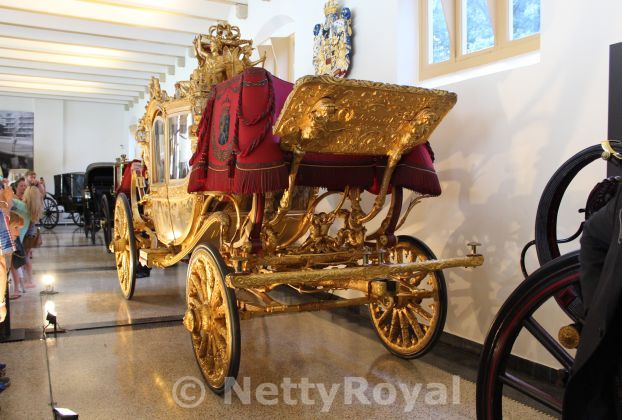
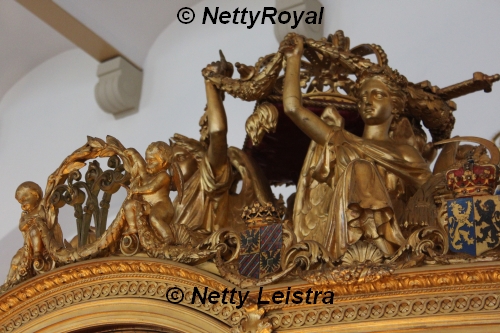
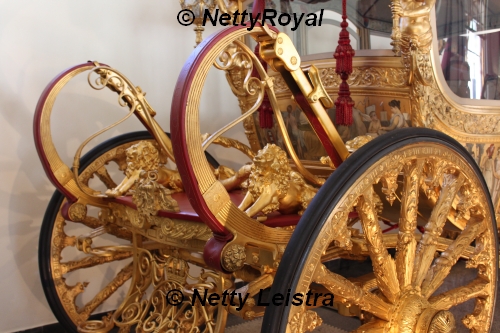
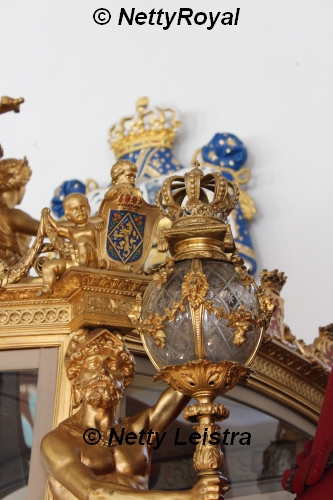
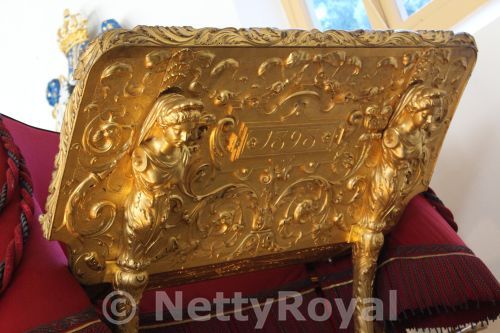
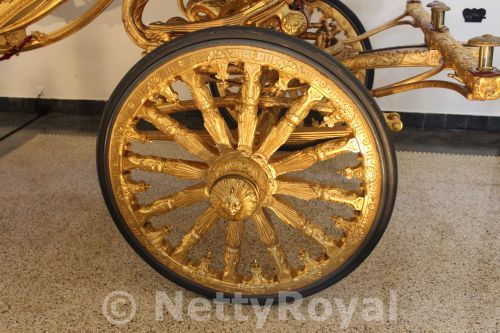
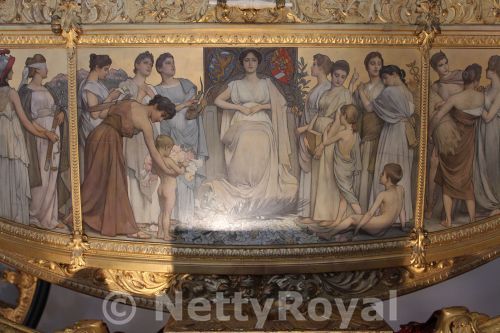
Thank you for this look at this beautiful carriage! Every detail is exquisite and hopefully one day there will be a photo to post of the current King and Queen riding in it during an extra special event.